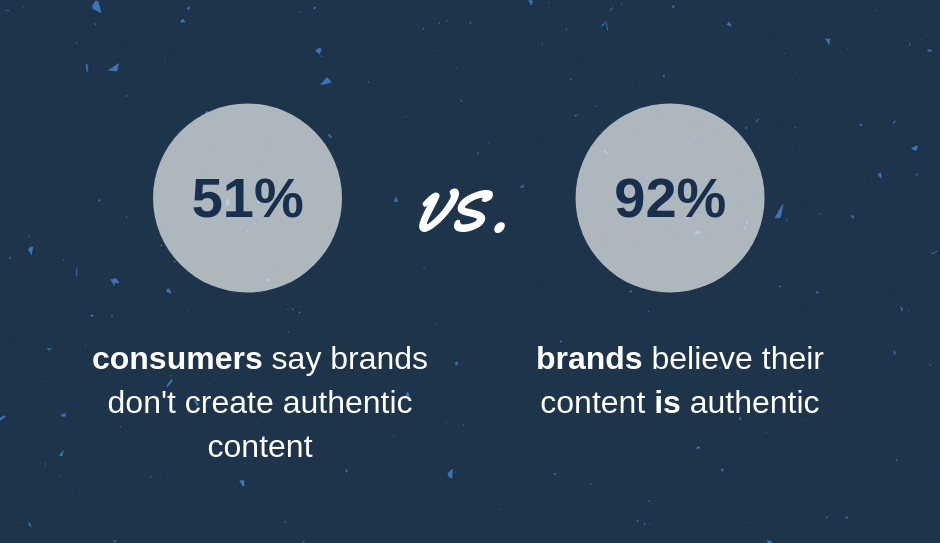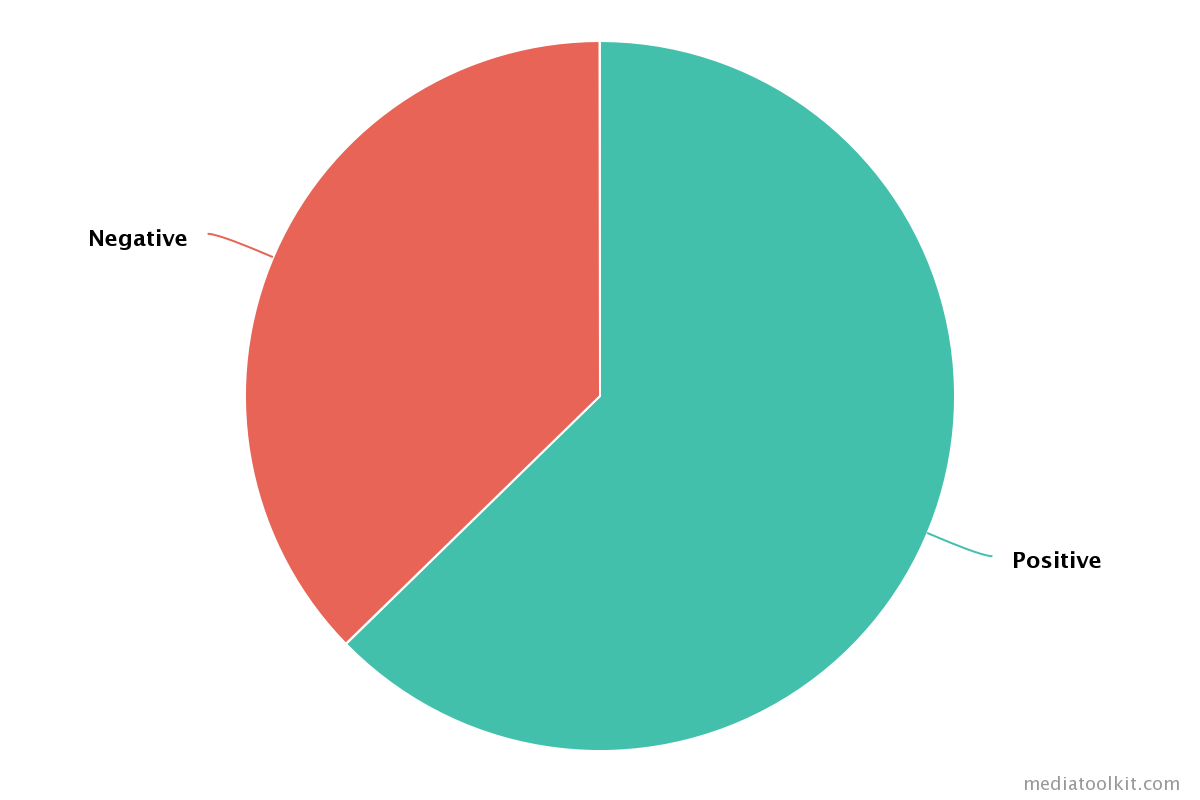How well do marketers really know their consumers?
Contrary to (our) popular belief, not very well.
A study by Stackla has raised some very interesting points for all those feeling rather confident about the content they produce for their desired audience. The most important being: there’s a noticeable gap between the content marketers create and content consumers actually want.

In fact, 51% of consumers say less than half of brands create content that resonates as authentic, while that percentage is a lot higher from marketers’ perspective (92% of marketers believe their content is authentic).
? Read Creating a Marketing Strategy that Works: Benefits, Steps, Tools
Both marketers and consumers agree on the importance of authentic content, however, the disconnect happens in their understanding of the same. While consumers are 2.4 times more likely to say user-generated content (UGC) is more authentic than the brand-created one, marketers think exactly the opposite. They are 2.1 times more likely to say brand-created content is the authentic one.
What’s more, 79% of consumers say that UGC highly impacts their purchasing decisions, while only 13% say brand-created content is considered impactful. The percentage is even lower for influencer-created content (a mere 8%).
Not only that, but consumers nowadays seek personalization. They want personalized experiences, tailored exactly to their needs and they are (mostly) not getting them.
Why is that?
Consumer empowerment is at an all-time high. Consumers are more informed than ever and they know exactly what they want, where and how they want it. They are the ones dictating the supply (of content, products, and services). And they are aware of the power they have, which is why there’s discontent when their needs are not being met.
While aware of the rising power of consumers, marketers don’t seem to know how to use it to their advantage, as Stackla’s research has shown us.
The root of the problem seems to be the misunderstanding of what consumers consider relevant, as opposed to what marketers think is relevant. If marketers are acting on impulse, intuition or guesswork when it comes to anticipating consumers’ needs, this misunderstanding will continue to happen.
That is why it’s important to make informed decisions. Decisions backed by irrefutable data, feedback and insight into the target audience.
And only then turning them into action.
Collecting the data
56% of consumers say the type of content they most want to see from brands are user-generated photos and videos. What’s more, 51% of them say they’d be more likely to continue engaging with and/or purchasing from a brand if it shared their photo, video or post as part of their marketing activities.
Why not take it a step further, though, and directly engage consumers? Insert yourself into their social media conversations, show them you see them, want to interact with them and care about their needs. Offer them a personalized experience.
Imagine yourself as a consumer that had a query on Twitter asking for advice on the next travel destination. Then imagine receiving an answer directly from a tourist agency or a hotel in Lisbon asking you to come and visit them. You’d feel special that a brand addressed you specifically, using a personalized approach, instead of addressing a general public you might be a part of.
How do you reach those people, though?
Media monitoring
Social listening is one way to do it. Media monitoring tools help you track whatever it is you deem relevant to your niche.
Let’s say you’re a travel agency. You’d want to track hashtags such as #travel, #travelholic, #travelblogger, and #vacation. Or you can track phrases like “where to travel”, “next travel destination” and “ideas for vacation”.
Not only will you discover a great amount of user-generated content – pictures, videos and blogs from all over the web (that, if relevant, you can then share on your social media), you’ll also learn what are the most visited destinations and what people are talking about those destinations. You’ll get first-hand knowledge about their experiences.
The data is right there – 89% of people said they would post about their positive purchasing experience when it comes to travel destinations. Imagine the amount of content you could get your hands on with the help of media monitoring tools.
You could discover a whole new world of potential consumers and if you choose to engage them, you’ll raise awareness of your brand while simultaneously offering them a solution for their needs.
Having insight into the number of mentions and impressions, sentiment analysis, top influencers or even competition analysis – in other words, having quantitative data, means having a basis for making informed decisions.
And making informed decisions means bridging the gap between what the consumers truly want and need and what the marketers create.
This would mean, for instance, knowing what are the most talked-about travel destinations, and centring your content around them. Write a blog about Lisbon, share user-generated content – photos or videos of people that have recently been there. Or maybe even give 20% off on Lisbon travel arrangements by directly answering consumers’ queries on social media.
This approach would also mean zero assumptions, as you would be basing your content on relevant data accumulated through online chatter. It’s like conducting market research on a daily basis – a more affordable, real-time research built on unbiased data.
Suggested read: How can Determ help you create relevant content?
All about that data
While media monitoring is an excellent way of collecting valuable data, that doesn’t mean it’s the only one you should use. The more primary sources you have, the better.
Surveys are always a good (and inexpensive) idea. There’s plenty of online survey sites where you can create customized surveys, depending on your needs, and send them to a specifically targeted audience or make them public so anyone can fill them out.
Furthermore, a great metric for measuring your customers’ experience is Net Promoter Score. It is useful for figuring out exactly how your brand is positioned in your customers’ consciousness. And it is all based on one key question: how likely are you to recommend the brand to others? If the answer is very likely, you know you have loyal customers. On the other hand, if you don’t score that well, it’s time to start asking questions. Why being at the forefront. Is the problem a lack of personalization, irrelevant content or something other? Maybe you’ll find out that what you’re supplying doesn’t really match what your customers are demanding.
But at least you’d know (and be able to act).
Analyzing the collected data
Collecting the data is great, yes, but data without proper analysis isn’t worth much. That’s why media monitoring tools, besides acquiring an extensive amount of information from the internet, also create your reports for you. Determ, specifically, has three report dashboards – basic, advanced and competitive analysis reports. You can also create a custom dashboard for a more personalized approach to analyzing your data.
For instance, if you want to know how interested people are in Lisbon currently, you’ll track queries such as “lisbon”, “portugal” or trending hashtags (#lisbon, #lisboa). For a “popularity” test you’ll want to know the number of mentions and impressions those queries accumulated over a period of a month. If that number is relatively high, you hit the jackpot. For now.

You’ll want to delve deeper, though. The number might be high, but you don’t know why is that so. Are the people genuinely interested in Lisbon, have great experiences and want to travel there or…not? Sentiment analysis is especially important here, as it gives you insight into whether the dominant sentiment is positive or negative.
Having a lot of mentions can definitely be great. However, if most of them are negative, do you really want to focus your content on something people find disagreeable?
It might bring you more bad than good.
This is why data analysis is important – you have to understand the data you have before you act on it.
Be consistent
However, you shouldn’t collect and analyze data sparsely, when you think you might need it. Consistency is key.
Don’t just focus on one campaign at a time, but rather consistently use media monitoring to further your business.
Keeping up with user-generated content is only one-way social listening can be of use. Take your brand reputation, for instance. You always want to know how you are positioned in your consumers’ consciousness. By tracking your own brand’s name or brand-related keywords, you can get insight into the public’s general opinion. No more “they like me, they like me not” guesswork. You’ll know for sure the way your audience feels about you.
Furthermore, you can stay ahead of possible crises, take advantage of possible viral content and discover new opportunities.
Truly, using media monitoring tools on a daily basis means being well-versed in your overall online presence and ways to make the best of it.
Let me leave you with one last statistic. 96% of people talking about companies and brands on social media aren’t actively following those brands.
The potential is obviously there. It’s up to you to find those people and engage them in conversation. Be relevant, personalize your communication and listen to their needs.
Let’s all work on making that marketer-consumer gap smaller.



